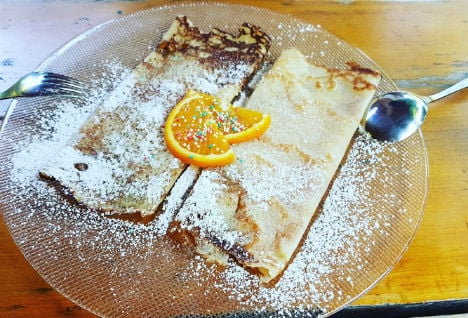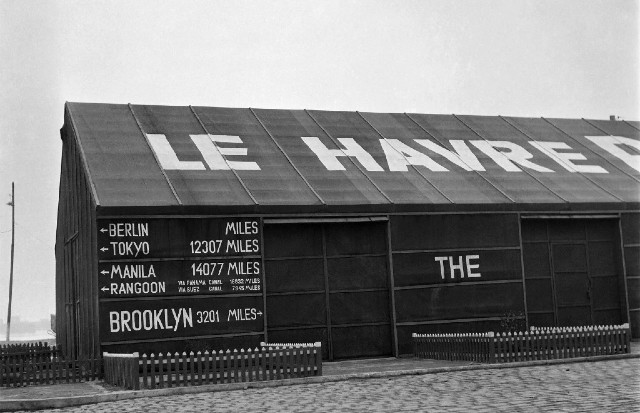Regional dialects and culinary traditions can complicate the matter because everyone seems to stick to their own terms for slippers, or for what to call their particular “local cuisine” – even if it's essentially the same recipe as in the state next door.
Ordering a Pfannkuchen in Berlin might get you your jelly-filled donut, but doing the same in most other places in Germany will get you a pancake. In Austria however, you need to ask for Palatschinken.
Here are a look at some of the concepts that the German language could perhaps consolidate a bit, based on research by Spiegel Online, Tages-Anzeiger and the app “Dialäkt Äpp”.
1. There are at least 25 different words for hiccup
What’s the German word for hiccup? That depends on who you ask and where. You might hear the more standard Hochdeutsch (high German) term Schluckauf.
Or Hädscher is you’re in the region of Franconia in central to southern Germany. And venture even further south to hear Hecker, Schnackler or even Schnackerl in Austria.
And of course the Swiss have to put their cutesy -i ending on their term: Hitzgi.
2. There are 12 different words for a pancake
For an English-speaker, the term Pfannkuchen makes the most sense as a literal translation of pancake (Pfanne means pan, Kuchen means cake). But while this word is understood in most of the country to be a round, flat, pan-cooked treat, in and around Berlin the word actually refers to jelly-filled donuts. Berliners – as well as other east Germans – prefer the term Eierkuchen for pancake.
And it’s not just Berlin that has its own name for the fairly standard breakfast fare.
Das Omlett or die Omelette is preferred in the west, particularly near the borders with France, or around German-speaking parts of Switzerland.
And then there’s Plinse or Plinz, which is heard near Leipzig or along the Polish border, which is basically a pancake, though English speakers might call them blintzes.
In Austria, the term Palatschinke, or Palatschinken is used.
3. There are 12 words for a gingerbread man
We dare you to find another English term for gingerbread man, but in the German-speaking world, it might actually be hard to agree on just one.
The term Lebkuchenmann is almost never spoken in the far west of Germany, according to Spiegel, but it seems to be the standard in cities like Munich, Berlin and Hanover.
Weckmann or Weckmännchen is far more preferred in the Rhineland and southwest, while Stutenkerl (literally fruit loaf fellow) is preferred in the northwest of Germany. But the difference in regional recipes might be part of why there are various names: Lebkuchen is a spiced dough, more similar to gingerbread, while Stuten often has raisins.
The area around Stuttgart and Karlsruhe seems to have its own unique name for such a dessert: Dambedei.
Meanwhile the man-shaped festive treat enjoyed within Austria is named after the region’s sinister demon creature who punishes bad children at Christmas time: Krampus.
4. 15 words for what’s basically a meatball
If you’ve sampled German and Austrian cuisine, you know a lot of it has to do with ground meat, whether in a sausage or other form.
So perhaps it’s not surprising that there is debate about what to call what is essentially a meatball.
Frikadelle, if you live in central west to northwest Germany, but Fleischküchle if in the southwest. Klops or Kloss in certain parts of east Germany, especially around Leipzig. But Beefsteak is even quite common for both Leipzig and Dresden.
And Fleischplanzl or Fleischpflanzerl if in Bavaria, especially Munich. And when in Austria, ask for Faschierten Laibchen, commonly called Fleischlaberl.
5. Nine different words for making small talk
There are certainly a number of colloquial phrases for having a casual chat in English – shooting the breeze in the US or having a chitchat in the UK. But German speakers seem to really like thinking up words for this daily ritual.
Quatschen is a favourite in both east and west Germany, though not so much right in the middle. Ratschen is much more common in south Germany, while the north and northwest seem to like klönen.
Schnacken is also a fun one from the north, around Hamburg. And babbeln is a good one to throw out there when in Hesse or Baden-Württemberg. In Austria, it’s more common to hear tratschen.
6. ‘Slippers’ come in ten varieties
You might have learnt to call your cozy, well-worn slippers Pantoffeln, but not everyone would agree with this vocabulary. In Austria, you’re more likely to hear them called them Schlapfen.
You could call them the almost Dr Seuss-sounding Schluffen, but that’s really only used in the western Rhineland, and perhaps in Frankfurt.
Just referring to them as Hausschuhe will probably get you the farthest no matter where you are in the German-speaking world. But you might also be tempted to use this fun-to-say east German word: Bambuschen.
7. 11 ways to talk about a slingshot
Ok German speakers, how many words do you need for slingshot? Apparently at least 11: Schleuder, Zwille, Fletsche, Flitsche, Katsche and more.
Are all of them really necessary?
8. 14 ways to mash potato
Part of the great variety on this one is that Austrians and southern Germans often say Erdapfel (literally ‘earth apple’) instead of Kartoffel. And on top of that you can add the ending of -brei, -püree or stock, depending on where you live.
But then there are those Germans who live in the historical region of Upper Lusatia in the east near Poland and the Czech Republic who have their own word for the dish: Mauke.
9. More than 50 words for the end piece of bread
We at The Local struggled to find just one English word to define the end piece of a loaf of bread. But perhaps we should steal one from Germans, because they have at least 51 different ways to describe this concept.
Which one’s your favourite? Take your pick:
-
Kanten – throughout Germany
-
Kante – mostly Germany
-
Anschnitt – mostly Baden-Württemberg
-
Anhau – parts of Switzerland
-
Kipf – mostly southern Germany, around Munich
-
Kipfel – mostly southern Germany and Hesse
-
Ranft – southern, central and eastern Germany
-
Ränftchen – centre and east Germany
-
Raftl – not so common: parts southern Germany and Austria
-
Rankl – mostly Bavaria
-
Rämpftla – Bavaria and Saxony
-
Knorze – Hesse and Rhineland-Palatinate
-
Knorzen – Frankfurt
-
Knust – throughout Germany
-
Knüstchen – mostly central west Germany
-
Knietzchen – the very centre of Germany
-
Kniesje – near the border with France
-
Knäuschen – mostly west and southwest
-
Knäusle – mostly Baden-Württemberg
-
Knerzel – Hesse and Rhineland-Palatinate
-
Knetzla – Mostly Cologne and Nurenberg
-
Knerzje – Rhineland-Palatinate
-
Scherz – parts of Bavaria and Austria
-
Scherzel – parts of Bavaria and Austria
-
Scherzerl – parts of Bavaria and Austria
-
Zipfel – Vienna, parts of Switzerland and southern Germany
-
Kruste – mostly western germany and Frankfurt
-
Krust – Cochem, Rhineland Palatinate
-
Krüstchen – mostly western Germany
-
Kirschte – parts of west Germany
-
Kierschtsche – parts of west Germany
-
Korscht – parts of west Germany
-
Kuuscht – parts of west Germany
-
Kürstchen – parts of west Germany
-
Knäppke – west and northwest Germany
-
Knippchen – parts of west Germany
-
Mürggu – Switzerland
-
Mirggel – parts of Switzerland
-
Muger – parts of Switzerland
-
Mutsch – parts of Switzerland
-
Küppla – parts of northern Bavaria
-
Küpple – central Germany
-
Köppla – parts of northern Bavaria
-
Kübbele – central Germany
-
Reifle – parts of southern Germany
-
Riebele – mostly Baden-Württemberg, but also Bonn and Hamburg
-
Rindl – parts of Bavaria and east Germany
-
Chäppeli – Switzerland
-
Chäppi – Switzerland
-
Houdi -Switzerland
-
Das Ende – various parts of Germany




 Please whitelist us to continue reading.
Please whitelist us to continue reading.
Member comments